外研版(2019)选择性必修第一册Unit 4 Meeting the muse Listening & Speaking课件(共21张,内嵌视频)
文档属性
| 名称 | 外研版(2019)选择性必修第一册Unit 4 Meeting the muse Listening & Speaking课件(共21张,内嵌视频) |  | |
| 格式 | pptx | ||
| 文件大小 | 37.9MB | ||
| 资源类型 | 教案 | ||
| 版本资源 | 外研版(2019) | ||
| 科目 | 英语 | ||
| 更新时间 | 2024-10-11 15:07:52 | ||
图片预览

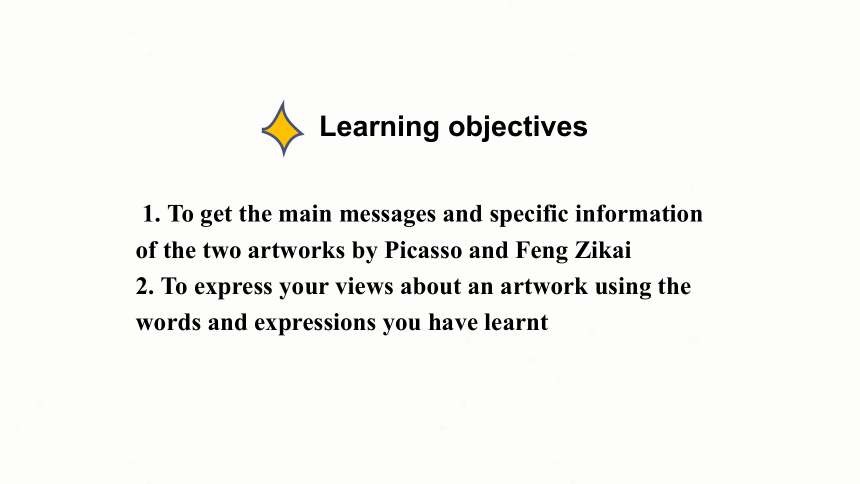
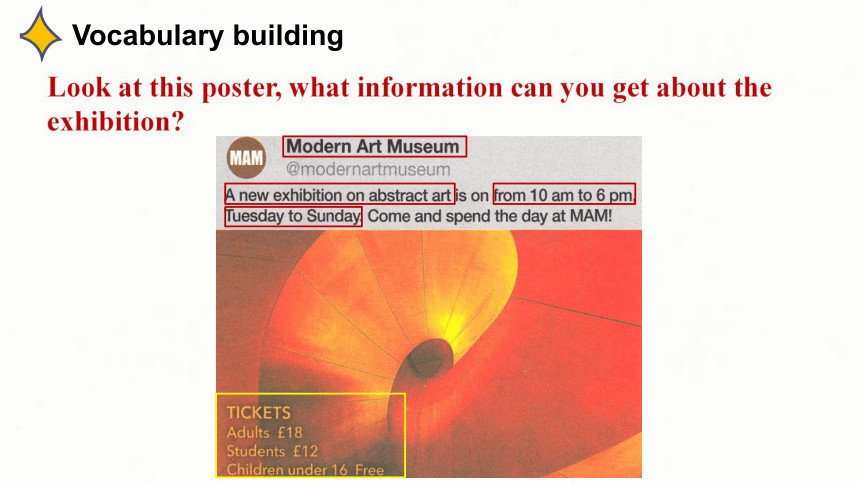
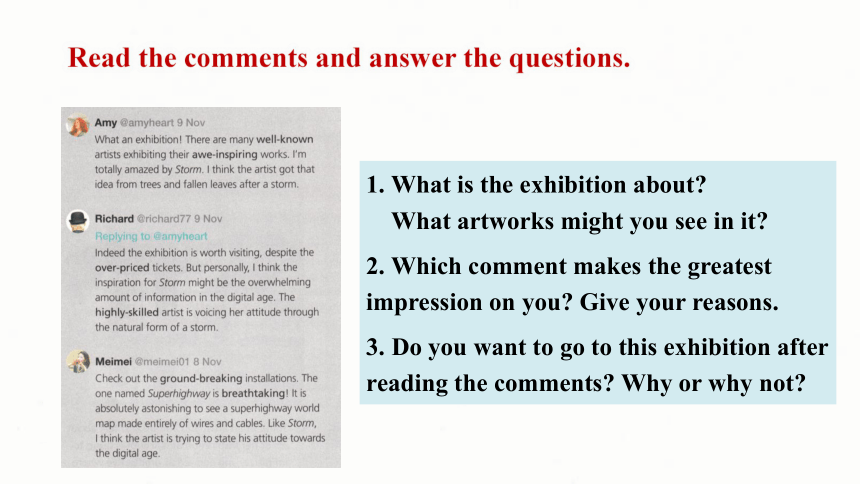
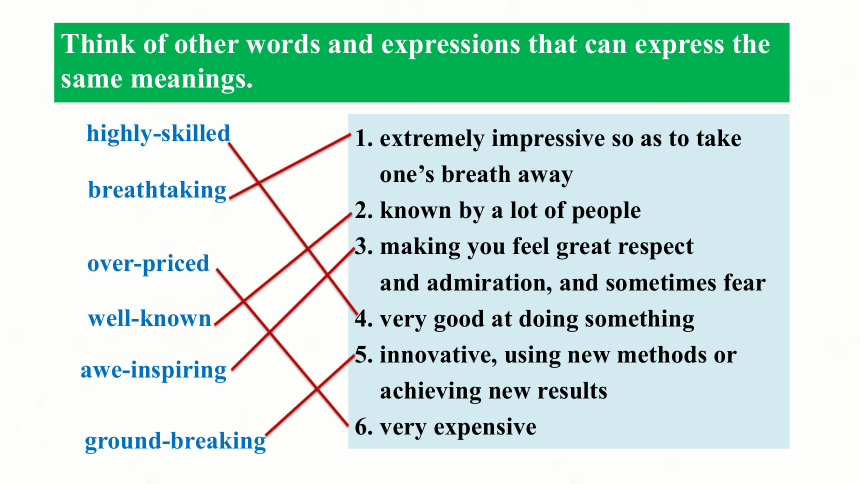
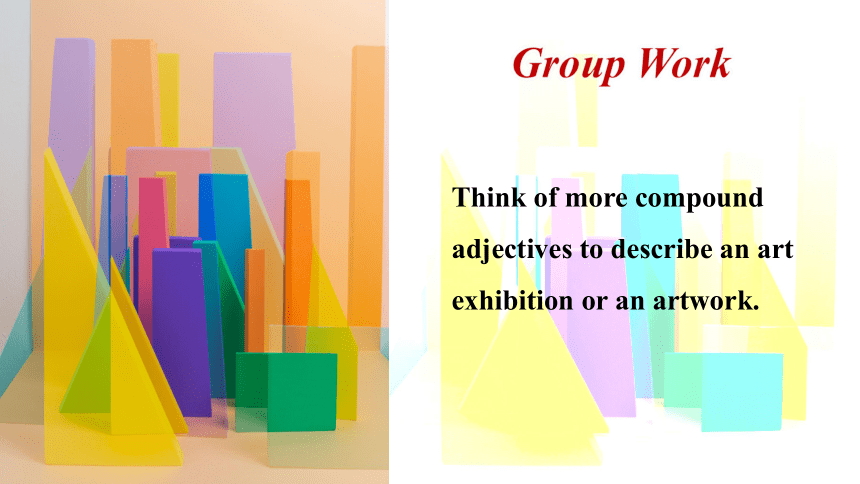
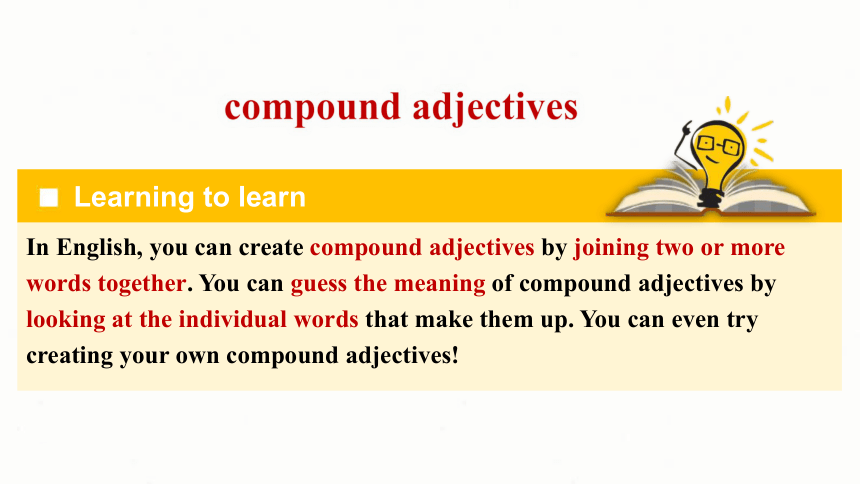
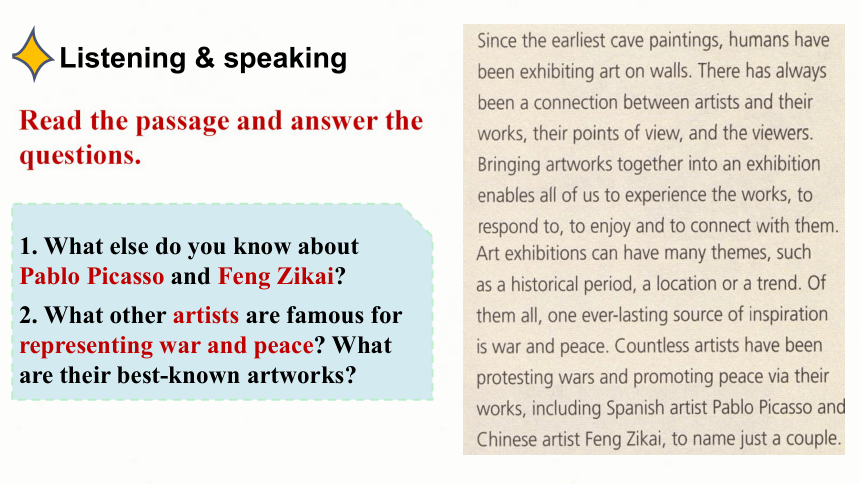
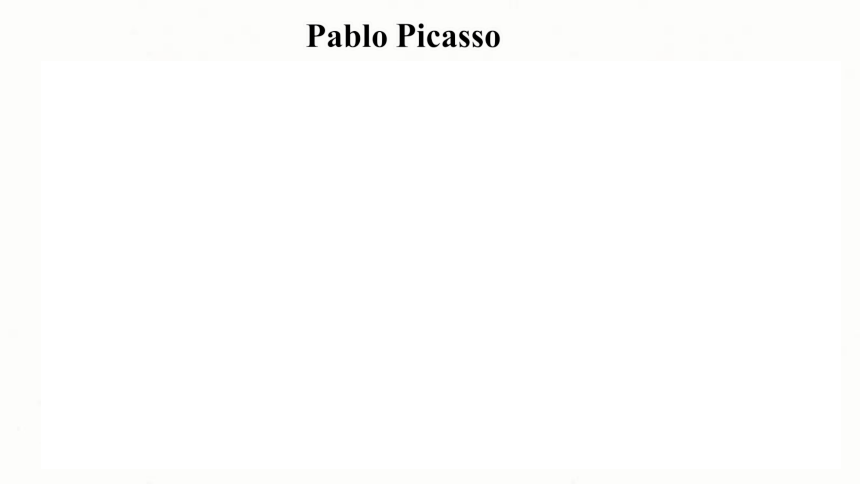
文档简介
(共21张PPT)
Unit 4 Meeting the muse
Period 4 Listening & Speaking
1. To get the main messages and specific information of the two artworks by Picasso and Feng Zikai
2. To express your views about an artwork using the words and expressions you have learnt
Learning objectives
Look at this poster, what information can you get about the exhibition
Vocabulary building
Read the comments and answer the questions.
1. What is the exhibition about
What artworks might you see in it
2. Which comment makes the greatest impression on you Give your reasons.
3. Do you want to go to this exhibition after reading the comments Why or why not
Match the compound adjectives to their meanings.
breathtaking
well-known
awe-inspiring
highly-skilled
over-priced
ground-breaking
1. extremely impressive so as to take
one’s breath away
2. known by a lot of people
3. making you feel great respect
and admiration, and sometimes fear
4. very good at doing something
5. innovative, using new methods or
achieving new results
6. very expensive
Think of other words and expressions that can express the same meanings.
Think of more compound adjectives to describe an art exhibition or an artwork.
Group Work
Learning to learn
In English, you can create compound adjectives by joining two or more words together. You can guess the meaning of compound adjectives by looking at the individual words that make them up. You can even try creating your own compound adjectives!
compound adjectives
Read the passage and answer the questions.
1. What else do you know about Pablo Picasso and Feng Zikai
2. What other artists are famous for representing war and peace What are their best-known artworks
Listening & speaking
Pablo Picasso
Feng Zikai
Listen to the audio guide and find out the main message of each artwork.
Guernica
The Battlefield
in Spring
Listen again and complete the notes.
Guernica, by Pablo Picasso
Painted after 1___________________ of Guernica
Size: 2___________________________________________
Images: a bull, a horse, a light bulb and a(n)
3___________________ lying on the ground
Using only three colours for 4___________________
the attack on the town
3.5 metres in height and almost 8 metres in width
dead or wounded man
a more powerful effect
Check the answers
The Battlefield in Spring, by Feng Zikai
Painted 5__________ Japanese aggression against China
Images: sandbags, an army cap, a wire fence and
6_______________
Contrast achieved with 7_________________
_________________
Showing Feng Zikai’s 8___________________
___________________
___________________
in protest of
some grass leaves
the lifeless objects
and the grass leaves
encouragement to the
Chinese people as well
as his hope for peace
Check the answers
The title of this painting is Guernica. It was painted by the well-known Spanish artist, Pablo Picasso. Picasso painted this huge, breathtaking painting after the attack on the town of Guernica by the Nazis. It measures about 3.5 meters in height and almost 8 meters in width, and contains many different elements. In the center of the painting, we can see a bull, a horse, a light bulb and a dead or wounded man lying on the ground. There have been endless debates about the meaning of these images, but Picasso insisted that it wasn't up to the painter to define them. He said that people must interpret the images as they understand them. Through these images, I can see the tragedy of wan, and feel the people's fear as well as Picasso's anger towards the fighting. In the painting, Picasso uses only three colors: black, white and grey. In my opinion, this makes its effect more powerful than using a full range of colors.
Listening scripts
Let’s take a look at The Battlefield in Spring by Feng Zikai, who was one of the pioneers of modern Chinese cartoons. His illustrations deal with complex social issues in a simple and lively way, and are widely loved by Chinese people. This Chinese cartoon is painted in protest of Japanese aggression against China. In this cartoon, you can see a small section of a battlefield, made up of sandbags, an army cap and a wire fence. On one of the sandbags grows some grass leaves. The lifeless objects together with the grass leaves create a strong contrast. Unlike Guernica, I personally think this cartoon delivers quite an optimistic message. It shows that the destruction of war is only temporary, and that the power of life is everlasting. I can feel the strong spirit and hope in this cartoon. It is widely believed that the grass shows Feng Zikai's encouragement to the Chinese people as well as his hope for peace. Through his war cartoons, he wanted to express his belief that Chinese people would win the war and bring peace back to the country.
Guernica
The Battlefield
in Spring
Pair Work
Discuss which artwork makes the greater impression on you and why. Listen again if necessary.
About an artwork: Basic information
… by the well-known …
It measures …
It is widely believed …
… by the well-known …
It measures …
In the centre of the painting,
we can see …
Through … , I can see / feel …
Complete the table with the expressions from the audio guide.
In my opinion, this makes …
… create a strong contrast.
I personally think …
It is widely believed …
About an artwork: What you see
In the centre of the painting, we can see …
Through… , I can see…
… by the well-known …
It measures …
In the centre of the painting,
we can see …
Through … , I can see / feel …
Complete the table with the expressions from the audio guide.
In my opinion, this makes …
… create a strong contrast.
I personally think …
It is widely believed …
… by the well-known …
It measures …
In the centre of the painting,
we can see …
Through … , I can see / feel …
Complete the table with the expressions from the audio guide.
In my opinion, this makes …
… create a strong contrast.
I personally think …
It is widely believed …
About an artwork: How you feel
Through… , I can feel…
I personally think …
… create a strong contrast.
In my opinion, this makes …
Choose an art exhibition, or an artwork from an exhibition you like, and write about it using the words and expressions in this section.
Useful expressions
Homework
Unit 4 Meeting the muse
Period 4 Listening & Speaking
1. To get the main messages and specific information of the two artworks by Picasso and Feng Zikai
2. To express your views about an artwork using the words and expressions you have learnt
Learning objectives
Look at this poster, what information can you get about the exhibition
Vocabulary building
Read the comments and answer the questions.
1. What is the exhibition about
What artworks might you see in it
2. Which comment makes the greatest impression on you Give your reasons.
3. Do you want to go to this exhibition after reading the comments Why or why not
Match the compound adjectives to their meanings.
breathtaking
well-known
awe-inspiring
highly-skilled
over-priced
ground-breaking
1. extremely impressive so as to take
one’s breath away
2. known by a lot of people
3. making you feel great respect
and admiration, and sometimes fear
4. very good at doing something
5. innovative, using new methods or
achieving new results
6. very expensive
Think of other words and expressions that can express the same meanings.
Think of more compound adjectives to describe an art exhibition or an artwork.
Group Work
Learning to learn
In English, you can create compound adjectives by joining two or more words together. You can guess the meaning of compound adjectives by looking at the individual words that make them up. You can even try creating your own compound adjectives!
compound adjectives
Read the passage and answer the questions.
1. What else do you know about Pablo Picasso and Feng Zikai
2. What other artists are famous for representing war and peace What are their best-known artworks
Listening & speaking
Pablo Picasso
Feng Zikai
Listen to the audio guide and find out the main message of each artwork.
Guernica
The Battlefield
in Spring
Listen again and complete the notes.
Guernica, by Pablo Picasso
Painted after 1___________________ of Guernica
Size: 2___________________________________________
Images: a bull, a horse, a light bulb and a(n)
3___________________ lying on the ground
Using only three colours for 4___________________
the attack on the town
3.5 metres in height and almost 8 metres in width
dead or wounded man
a more powerful effect
Check the answers
The Battlefield in Spring, by Feng Zikai
Painted 5__________ Japanese aggression against China
Images: sandbags, an army cap, a wire fence and
6_______________
Contrast achieved with 7_________________
_________________
Showing Feng Zikai’s 8___________________
___________________
___________________
in protest of
some grass leaves
the lifeless objects
and the grass leaves
encouragement to the
Chinese people as well
as his hope for peace
Check the answers
The title of this painting is Guernica. It was painted by the well-known Spanish artist, Pablo Picasso. Picasso painted this huge, breathtaking painting after the attack on the town of Guernica by the Nazis. It measures about 3.5 meters in height and almost 8 meters in width, and contains many different elements. In the center of the painting, we can see a bull, a horse, a light bulb and a dead or wounded man lying on the ground. There have been endless debates about the meaning of these images, but Picasso insisted that it wasn't up to the painter to define them. He said that people must interpret the images as they understand them. Through these images, I can see the tragedy of wan, and feel the people's fear as well as Picasso's anger towards the fighting. In the painting, Picasso uses only three colors: black, white and grey. In my opinion, this makes its effect more powerful than using a full range of colors.
Listening scripts
Let’s take a look at The Battlefield in Spring by Feng Zikai, who was one of the pioneers of modern Chinese cartoons. His illustrations deal with complex social issues in a simple and lively way, and are widely loved by Chinese people. This Chinese cartoon is painted in protest of Japanese aggression against China. In this cartoon, you can see a small section of a battlefield, made up of sandbags, an army cap and a wire fence. On one of the sandbags grows some grass leaves. The lifeless objects together with the grass leaves create a strong contrast. Unlike Guernica, I personally think this cartoon delivers quite an optimistic message. It shows that the destruction of war is only temporary, and that the power of life is everlasting. I can feel the strong spirit and hope in this cartoon. It is widely believed that the grass shows Feng Zikai's encouragement to the Chinese people as well as his hope for peace. Through his war cartoons, he wanted to express his belief that Chinese people would win the war and bring peace back to the country.
Guernica
The Battlefield
in Spring
Pair Work
Discuss which artwork makes the greater impression on you and why. Listen again if necessary.
About an artwork: Basic information
… by the well-known …
It measures …
It is widely believed …
… by the well-known …
It measures …
In the centre of the painting,
we can see …
Through … , I can see / feel …
Complete the table with the expressions from the audio guide.
In my opinion, this makes …
… create a strong contrast.
I personally think …
It is widely believed …
About an artwork: What you see
In the centre of the painting, we can see …
Through… , I can see…
… by the well-known …
It measures …
In the centre of the painting,
we can see …
Through … , I can see / feel …
Complete the table with the expressions from the audio guide.
In my opinion, this makes …
… create a strong contrast.
I personally think …
It is widely believed …
… by the well-known …
It measures …
In the centre of the painting,
we can see …
Through … , I can see / feel …
Complete the table with the expressions from the audio guide.
In my opinion, this makes …
… create a strong contrast.
I personally think …
It is widely believed …
About an artwork: How you feel
Through… , I can feel…
I personally think …
… create a strong contrast.
In my opinion, this makes …
Choose an art exhibition, or an artwork from an exhibition you like, and write about it using the words and expressions in this section.
Useful expressions
Homework
